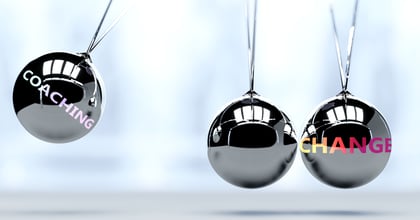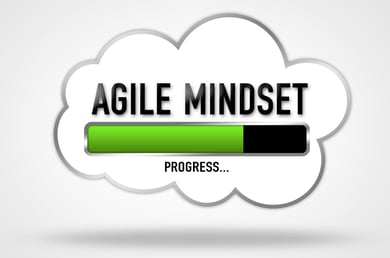
Agile Mindset: The Biggest Impediment to...
The 2022 Agile Coaching Report sat in my inbox for almost two months until I finally reviewed it in detail a few days ago. Several areas were worthy of a deeper dive, but one particularly struck me. The report's preface reads: "Notably, coaches believe the biggest impact they are making is in shifting an organization towards an agile mindset and culture. Interestingly, they also find this to be the most challenging shift to make and one of the biggest impediments to agility if not achieved." This sentiment isn't surprising to most who have worked in an organization transforming toward more agility. It's an issue Agile Coaches, Scrum Masters, leaders, managers, and team members run into often.
It's not surprising this shift is difficult because a transformation of an individual's mindset requires an internal change in their value system, which is not only what they say they value but what they believe they value. Unfortunately, leaders, managers, and stakeholders often say they value the agile transformation or value delivering useful products or services to their customers but underpinning those statements is a desire for more money, more accolades, more acceptance, and more power. There's nothing inherently wrong with some of these underpinning values, but it's essential to understand the true driver for the desire to change. It's important because our job as coaches is to nudge them toward more agile ways of thinking. And to do that, we must understand where the individual's values are rooted.
Mindset vs. Culture
The issue of shifting individual mindsets is compounded by entrenched corporate culture. We tend to talk about shifting mindsets and cultures as though they are the same. Yet they are quite different, though still connected. While mindsets are held by individuals, the organizational culture is a collective of those mindsets, sometimes even influenced by people who are no longer part of the company. The two feed off each other, both positively and negatively. Individual mindsets can influence the culture, particularly if it's the mindset of a leader or influencer in the organization. But culture can also influence mindsets, especially if the individual doesn't hold firm beliefs about important aspects of the culture. There's also a compounding effect when people who buy into the existing culture stay at a company while those who don't buy into it leave.
Let me illustrate this with a story. A few years ago, I worked with a large embedded systems company. They wanted to "go agile" and spent significant time, money, and effort in the transition. As part of the delivery team, I helped train and coach individuals at the leadership, management, and team levels on what agile was, how Scrum worked, and how the organization needed to change to affect the transformation it sought.
As we delivered the training, it was easy to see those who immediately got it. I could tell those whose personal values aligned with or easily shifted toward an agile mindset. It was equally evident who didn't buy into agility and whose mindsets leaned away from that set of underlying values.
As time passed, we had breakthroughs. In one sprint planning session, a senior developer for one of the teams blurted out, "I love agile!" But there were still laggards whose internal values were tightly connected to the old way of working. For this company, the corporate culture of rigid timelines and siloed work was too entrenched. Most senior leaders only paid lip service to the change and weren't willing to shift their own mindsets. As a result, the organization couldn't cross the chasm, and several talented people whose mindsets did change, left the company to seek other opportunities where agility was part of the culture. The upside to this engagement is that we still educated many talented individuals and helped them improve their careers. And since then, several have brought us into their new companies to help them continue their agile journey.
If Leadership Mindsets Don’t Change, Then Culture Won’t Change
Leaders shape organizational culture. Their mindsets must shift toward agility for an agile transformation to succeed.
Leaders and managers often lean on teams to make the structural changes of agile. They pay for Scrum training, invest in reorganizing the teams, add Product Owners and Scrum Masters, and say, "We're going agile," but their actions tell a different story. They still demand the same reports, the same metrics, and the same management processes while hoping that 2-week sprint cycles and daily standups will overcome the culture of the rest of the organization.
It won't.
While it's important that coaches work directly with teams so they understand how and why agility works, it's imperative that they coach leaders and managers on shifting their internal values. It's not good enough to let leaders get away with only saying the right things. They must actually change their behavior.
Dr. Rick Thomas posted a great article on LinkedIn about a year ago titled, The Cultural Impact(s) of Mindset. I encourage you to read it because there's lots of great stuff in it. I do feel Dr. Thomas lets leadership off the hook too easily. In his closing sentence, he writes, "Organizational renewal relies on the ability of leaders and/or positive influencers to shift the mindset of the workforce and to define, articulate and achieve new behavioural expectations that the workforce is expected to live into and exhibit as part of its culture." What gnaws at me is that he doesn't mention the need for leaders and/or positive influencers to shift their own mindsets. Maybe it's implied. Maybe there’s an assumption that the leaders’ mindsets already align with agility, but the problem with the closing statement is it pushes the behavioral expectations to the workforce while leaders are simply expected to define and articulate what those expectations are. The closing line leaves out the necessity that agile behaviors must be modeled by leaders, not simply defined and articulated.
The Biggest Challenge
As agile coaches, our biggest challenge is working up and down the organizational hierarchy to shift individual mindsets. It's simply not enough to train and coach the teams in hopes a grassroots movement will overcome the existing corporate culture. In addition to working with the teams, we must also work with the managers and leaders to instill the same behavioral changes we're asking the teams to make.
This is no simple task.
First, managers and leaders don't have the same types of work and tasks that teams do, so it's not always evident how, as coaches, we can get them to model more agile behavior. Second, some agile coaches don't have the experience or desire to work with senior management and corporate executives. It's not easy to schedule or do, and it can be intimidating work. But for agile adoption to truly succeed, it must be done. Otherwise, you'll have teams that look agile from the outside because they are going through the motions of doing Scrum, but there's no mindset shift nor a cultural shift in the organization, and many of the most valuable benefits of agility are left on the table.
Shifting at the Top
A few techniques Zenergy has found helpful in getting leaders to make the shift in their mindset and behaviors include:
-
Establishing an Agile Transformation Team (ATT) – this is a team of senior leaders, corporate executives, and/or directors who are charged with ensuring the success of the organization's agile transformation. This team creates the Agile Transformation Roadmap and executes it using Scrum. They have a Product Owner, usually the leader who is championing the agile transformation, a Scrum Master, who can be an agile coach or another leader, and team members made up of other leaders and executives. By using an ATT, the leaders experience the challenges of the new work routine and feel pressured to meet their Sprint Goals. We even suggest they demo their products, which tend to define and articulate organizational agile expectations. This parallels what Dr. Thomas suggests leaders should do, but the difference is that the leaders are also doing the work within a Scrum(like) framework.
-
Creating Communities of Practice (CoP) for Agile Managers – Communities of practice are a great way to expand agility in an organization, but there's a tendency to focus CoPs only on the tactics teams use to build and deliver products. Instead, this CoP invites managers to learn from each other how to build trust with their teams, update reporting requirements, and establish new, more agile-centric metrics and OKRs. Making the shift towards agility can be extremely difficult for a manager, and a CoP can help them see their position in new ways that benefit the organization and the agile transformation.
-
Receiving Agile Leadership Training – whether it's the Scrum Alliance's CAL training, ICAgile's Leading with Agility or some other agile leadership training, it's important for leaders to understand not only the basics of agile and Scrum but how their values and behaviors may need to shift to ensure a successful move toward more agility in their organization.
The benefit of each of these techniques is it helps leaders understand and apply agility. It gives them the opportunity to model agile behavior for the rest of the organization and has the potential to shift their individual mindsets, as well as the organization’s culture.
Wrapping Up
The biggest impediment in an organization's journey toward more agility is the need for team members, managers, and leaders to shift their mindset. By shifting individual mindsets, which may require realigning individual internal value systems, the organizational culture will also shift. Unfortunately, this isn't easy work, and not all agile coaches are able or willing to focus sufficient effort across all the relevant groups in the organizational hierarchy.
Introducing agile and providing insights on tactical-level techniques at the team level will likely get some quick converts to agility, but for it to stick, the organizational culture must shift as a whole. And to do that, leaders and managers, not just the teams, must be part of the agile journey too. That means agile coaches must create opportunities for internal feedback loops that help leaders and managers 1) understand their underpinning values and 2) align those values with the agile values.
It's not enough to ask the leaders to simply define and articulate a vision of organizational agility. Agile coaches must work with them to transform themselves, not just their teams, and to walk the walk because simply talking the talk is not enough and never was.
Need help with agile mastery? Contact us today.



